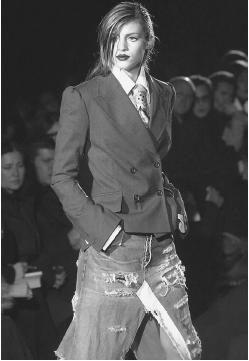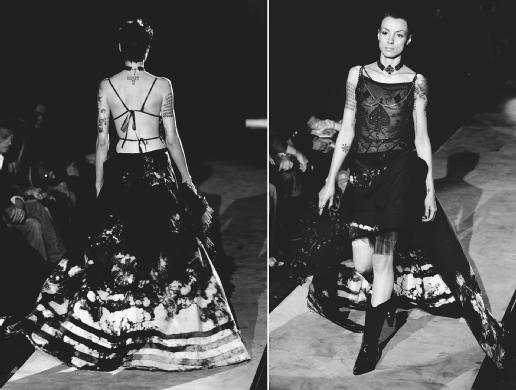John Richmond - Fashion Designer Encyclopedia
British designer
Born: Manchester, England, 1960. Education: Graduated from Kingston Polytechnic, 1982. Family: Married Angie Hill; children: Harley, Phoenix. Career: Freelance designer in England for Lano Lano, Ursula Hudson, Fiorucci, Joseph Tricot, and Pin Up for Deni Cler, 1982-84; designer/partner with Maria Cornejo, Richmond-Cornejo, London, 1984-87; introduced John Richmod Man and John

Publications
On RICHMOND:
Books
Thackara, John, ed., New British Design, London, 1986.
McDermott, Catherine, Street Style: British Design in the 1980s, London, 1987.
de La Haye, Amy, ed., The Cutting Edge: Fifty Years of British Fashion, 1947-1997, New York, 1997.
Debrett's People of Today, London, 2001.
Articles
"All Right John?" in the Sunday Express Magazine (London), 3 August 1986.

"Design Duo Separate," in Fashion Weekly (London), 12 November 1987.
"Richmond/Cornejo," in the Sunday Times Magazine (London), 22 November 1987.
Scott-Gray, Chris, "Designing Contradictions," in Fashion Weekly (London), 6 October 1988.
Collen, Matthew, "Maximum Impact," in i-D (London), December/January 1989-90. Ferguson, Sarah, "Cyclist," in Elle (New York), April 1991.
"John Richmond," in Face (London), September 1991.
Fallon, James, "Richmond the Destroyer," in DNR, 6 July 1992.
Gordon, Mary Ellen, "Rock 'n' Roll Control," in WWD, 18 November 1992.
Clemente, Alba, "Limelighting John Richmond," in Interview, January 1993.
"Real Shopping: Style Police—Look, No Hands," in the Independent, 7 March 1999.
Bonas, Maurizio, "Milan Men's Wear Schedule," in DNR, 7-12 January 2000.
Zargani, Luisa, "Notebook from Milan: Valextra New Line," in Women's Wear Daily , 27 November 2000. "John Richmond," available online at the Fashion Page, www.fashionz.co.uk ; Fashion View, www.fashionview.com ; Moda Online, www.modaonline.it ; and at British Fur, www.britishfur.com ; 5 October 2001.
***
The twin icons of popular rebellion—rock music and biker chic— are combined with good tailoring and attention to detail to make John Richmond's designs a success, commercially and critically. He is one of the most business-minded of his British counterparts, steadily building up his clothing range while others have fallen prey to financial and production problems. His designs have developed along the lines initiated during his partnership with Maria Cornejo, with certain motifs being carried through. These make his work instantly recognizable and, he says, justify the use of the "Destroy" slogan as a brand name for his cheaper lines, instead of promoting it as a diffusion range.
Richmond's womenswear shows the use of sharp tailoring with subversive twists that carry out the motto of "Destroy, Disorientate, Disorder," so often emblazoned on his garments, as he tries to challenge accepted design conventions and expectations. Richmond's clothes are always sexy and brazen, leading many stylists and pop stars to reach for his styles when wanting to create a memorable and striking image. Well-cut jackets, often in hot fruity colors, are combined with fetish motifs. Bondage chains, zips, and leather inserts hark back to punk, although the sophistication of the style and the quality of the fabric make the overall look far more contemporary. His tattoo-sleeve tops and biker jackets were seen everywhere, even inspiring a vogue for the real thing among some London clubbers.
These design details also highlighted another side of his more subversive work. The macho tattoos he juxtaposed with transparent georgette wrap tops in the late 1980s questioned sexual stereotypes, something he continued in his menswear, where bright shiny fabrics were used for long-jacketed suits, and net was set against hard leather. These were perhaps a reflection of the vulnerable, slightly camp edge possessed by many of the rock heroes who inspired Richmond; impossibly masculine images, at the same time tempered by a glam-rock glitziness or the feminine twist of a soft shiny fabric. Although the anarchy symbols he so often used challenge, they never led to his creating unwearable or unsellable clothes. A suit might have been made with bondage trousers as a witty edge to a traditional design, but the fine Prince of Wales check of the fabric still made it seem stylish and desirable.
Richmond's Destroy and Destroy Denim labels had the same pop star/rock chic feel yet retained the quality of design of his main line, relying mainly on Lycra, denim, and splashes of leatherette to produce a sportswear influence and clubby feel. Jeans in denim and biker jackets formed the basis of this collection, although sharp suits also featured, with 1970s glam rock again an influence: feather boalike trim around coats and jackets and tight sequin tops for both men and women. Later collections showed a growing maturity in style and widening of influences, in couture-inspired jackets with gilt buttons and quilted linings and sleek slit skirts, still with the distinctive Richmond elements like shiny leggings and the contrast platform heels of the boots designed for Shelly's, the popular London footwear chain.
For the 1996-97 winter season, Richmond's second Milan showing stressed a distinctive sophistication merging sensuality with a cosmopolitan flair. He refined classic ensembles to suit a mature, worldly buyer who wanted to appear tasteful yet alluring. His dresses, which Forlí Red Falcon made and distributed, succeeded primarily because of Richmond's fabric and detailing savvy. For the modish, self-confident woman, he underscored uncomplicated lines.
Richmond made his mark on the season with devoré velvets, metallic woolens, delavé taffetas, and optical prints. The collection of skirts and day costumes tended to be well-fitted and long; tapered pants complemented crêpe georgette blouses. For casual wear, he relaxed the silhouette with twin sets, trapeze skirts, low-slung pant lines, and tight, figure-revealing tops. His choice of animal prints and skins, bi-tone gabardine, satin, suedes, and vinyl, and velvet for dresses provided texture and variety to suit more occasions and settings. His palette centered on black, dark umber, and navy, often offset by diagonal slashes of pink and burgundy. For some ensembles in his winter 2001-02 collection, Richmond, like Dior, Gucci, Chanel, Prada, Armani, and numerous other of the fashion world's top designers, chose fur, a material that Brenda Polan of the London Evening Standard connected with wealth, sex appeal, luxury, and glamor.
Additionally, in 2000, Richmond signed a three-year contract with Valextra, the Italian accessories firm, to design a new womenswear collection and coordinating accessories line featuring footwear and handbags. "I didn't want to work with just my company, and I don't really plan to do any other consulting," Richmond told Women's Wear Daily (27 November 2000), "I'm thinking of clothes that fit with the bags; I thought this was the easiest way to change people's perception of Valextra, to show how accessories fit into modern life."
—Rebecca Arnold;
updated by Mary Ellen Snodgrass
Comment about this article, ask questions, or add new information about this topic: